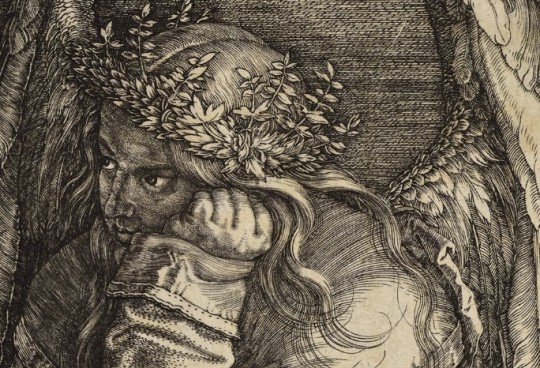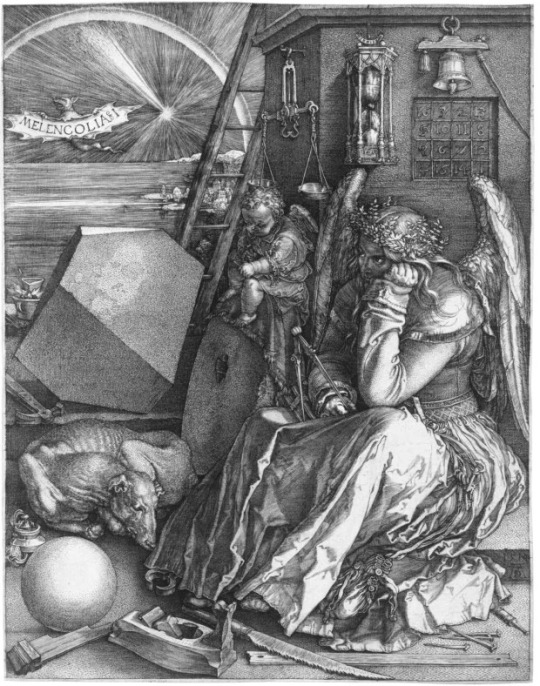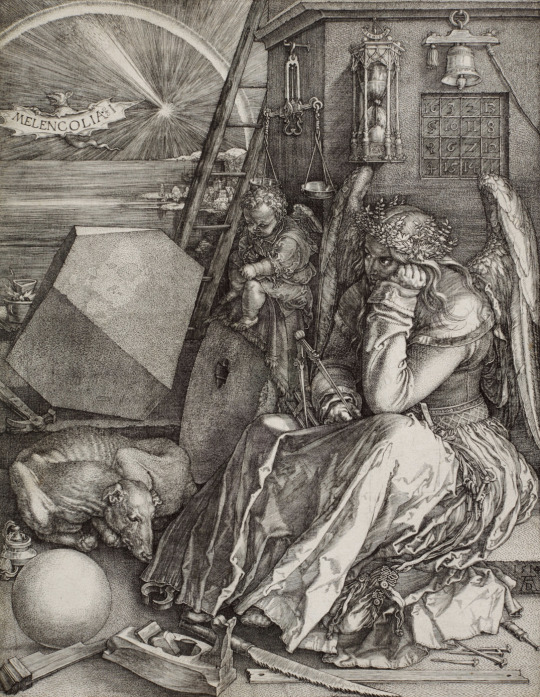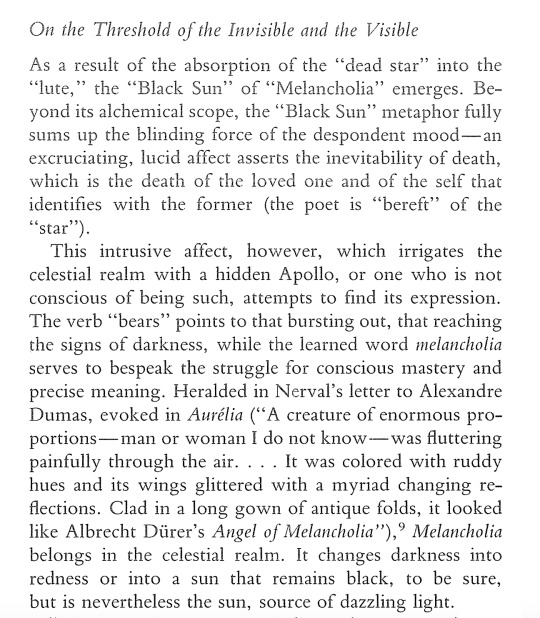#melencolia i
Text



Melencolia I (1514) and details - Albrecht Dürer
Die Melancholie (1514). – Ein geflügeltes Weib, das auf einer Stufe an der Mauer sitzt, ganz tief am Boden, ganz schwer, wie jemand, der nicht bald wieder aufzustehen gedenkt. Der Kopf ruht aus dem untergestützten Arm mit der Hand, die zur Faust geschlossen ist. In der andern Hand hält sie einen Zirkel, aber nur mechanisch: sie macht nichts damit. Die Kugel, die zum Zirkel gehört, rollt am Boden. Das Buch auf dem Schoß bleibt geschlossen. Die Haare fallen in wirren Strähnen, trotz dem zierlichen Kränzchen, und düster blicken die Augen aus dem schattendunklen Antlitz. Wohin geht der Blick? Auf den großen Block? Oder nicht eher darüber hinweg ins Leere? Nur die Augen wandern, der Kopf folgt nicht der Blickrichtung. Alles ist Müde, Dumpfheit, Regungslosigkeit.
Aber ringsherum ist's lebendig. Ein Chaos von Dingen. Der geometrische Block steht da, groß, fast drohend; unheimlich, weil es aussieht, als ob er fallen wollte. Ein halbverhungerter Hund liegt am Boden. Die Kugel. Und daneben eine Menge Werkzeuge. Hobel, Säge, Lineal, Nägel, Zange – alles ungenützt, unordentlich zerstreut.
Was soll das heißen? Als Erklärung steht oben, den Flügeln einer Fledermaus eingeschrieben, das Wort: MELENCOLIA I.
Heinrich Wölfflin. Die Kunst Albrecht Dürers (1905)
#dürer#albrecht dürer#melencolia I#melencolia#Melancholie#kunst#gravur#engraving#texts about art#bildbeschreibung#sprache und kunst#verbildlichung / verschriftlichung von mir beim these schreiben#ugh#melancholia
8 notes
·
View notes
Text


Dürer’s Magic Square
57 notes
·
View notes
Text


Akt
Wie kann Reinach so selbstbewusst darüber sprechen und schreiben, was ein Akt ist? Wo doch seine Kollegen laufend widersprechen!
Dafür, nach Vismann, bräuchte man nicht nur Bewußtein und nicht nur dessen Selbstreferenz. Sprechen und Schreiben sind auch Kulturtechniken, für die man Medien und Dinge, Stifte und Papiere braucht und in deren Praxis es nicht unbedingt auf das Selbstbewußtsein, weder auf das Selbst noch auf das Bewußtsein ankommt.
Antwort nach Vismann deswegen: Reinach kann über den Akt schreiben, wie er es tut, weil er die Akten händeln kann, er kann bestreiten, was ein Akt sein soll.
Der Workshop zu Adolf Reinach ist eine melancholische Tagung, hier wird gründlich und apriorisch gegrübelt.
4 notes
·
View notes
Text

Melencolia I. Albrecht Dürer.
5 notes
·
View notes
Photo

Solbi "now more profitable as a painter"...TMI Talk [asks heat to singer]2
0 notes
Text
<- Guy who had a really intense, productive therapy session today where he cried his eyes out and also recommended Pentiment to his therapist
#[through tears] yeah they just released it on a bunch more platforms#in my defense i was using a certain metaphor they did with melencolia that really resonated with me to explain a thing#but also. parody of myself
45 notes
·
View notes
Text

Albrecht Dürer
Melencolia I (Bartsch 74; Meder, Hollstein 75)
12 notes
·
View notes
Photo

No thoughts for Beatrice?
8 notes
·
View notes
Text
fun fact about Melencolia I by Albrecht Dürer! Many signs show that it’s a “self portrait” or at least a very personal artwork. He was actually suffering from melancholy, which at the time was considered a mental as well as a physical illness connected to the person’s bile. It was traditionally treated by the very plant that Dürer holds in his hands on an early self-portrait! He was also involved in mathematics, of which we see many depictions on the picture, like the compasses, etc… This artwork was made in 1514 when Dürer lost his mother, who was not only a familial figure, but also an artistic helper for him. Usually “Melencolia I” is interpreted as “melencolia one”, “I” meaning the roman numeral. But in latin “I” means something along the lines of “get away from me!”, “go away!”, which interpretation in the context of his personal life makes much more sense
39 notes
·
View notes
Text

Melencolia I (Albrecht Dürer, 1514)
44 notes
·
View notes
Text

Albrecht Dürer, Melencolia I, 1514
VS
OMA, Casa da Musica, Porto, Portugal, 1999-2005
#oma#casa da musica#porto#oporto#portugal#rem koolhaas#architecture#contemporary architecture#Albrecht Dürer#Melancholia#engraving#print#renaissance#rinascimento#geometry#Polyhedron
38 notes
·
View notes
Text

Loose sketch studying Albrecht Dürer’s Melencolia I
39 notes
·
View notes
Text
Local art museum has a Melencolia I print but it's not on display? Discrimination against me specifically.
#hello??#this isn't totally in jest i am writing another paper on melencolia i and would love to be able to go see one#yes i'm a museum guy yes i know how collections work#but also. also. come on
22 notes
·
View notes
Text
Tunesday 52

Also heard this week:
Anathema - Pentecost III
The Anchoress - "Asleep"
Arena - The Visitor
Blind Guardian - Tales from the Twilight World
Chapel of Disease - Echoes of Light
Cocteau Twins - Head over Heels
Concrete Blonde - Free
Chris Cornell - Euphoria Morning
Dali's Dilemma - Manifesto for Futurism
Damn the Machine - Damn the Machine
Dark Tranquillity - Skydancer
Disillusion - Back to Times of Splendor
Dokken - Erase the Slate
Mannequin Pussy - (advance singles from) I Got Heaven
Swords of Dis - Melencolia
Wuthering Heights - To Travel for Evermore
#tunesday#the replacements#blind guardian#tiles#arena#artension#crimson glory#sorcerer#leonard cohen#blondie
3 notes
·
View notes
Text
"The Disinherited" by Gérard de Nerval
I am the dark one,—the widower,—the unconsoled,
The prince of Aquitaine at his stricken tower:
My sole star is dead,—and my constellated lute
Bears the black sun of the Melencolia.
In the night of the tomb, you who consoled me,
Give me back Mount Posilipo and the Italian sea,
The flower which pleased so my desolate heart,
And the trellis where the grape vine unites with the rose.
Am I Amor or Phoebus?…Lusignan or Biron?
My forehead is still red from the kiss of the queen;
I have dreamed in the grotto where the mermaid swims…
And two times victorious I have crossed the Acheron:
Modulating turn by turn on the lyre of Orpheus
The sighs of the saint and the cries of the fay.
Translated by Robert Duncan

--Julia Kristeva, Black Sun: Depression and Melancholia
#Gérard de Nerval#literature#poetry#julia kristeva#kristeva#Robert duncan#black sun#melancholia#eclipse#death#psychoanalysis#depression#sun
5 notes
·
View notes
Text

Albrecht Dürer, Melencolia §I, 1514, copperplate engraving.
‘Shimmering with astral radiance and pulsing with unseen affinities among the scatter of things, the “intense atmosphere” of Melancholy’s thought space, described by Frances Yates as a projection of the occultist’s visionary stance, borders on the hallucinatory. Had Dürer left to posterity only this one document of his life and art, we would place him alongside Bosch as on the of great surrealists avant la lettre. Melancholy is like this, we intuitively hear the artist saying, and in the crowded tableau we imagine we have the mirror of an inner state. But whose inner state? Is Dürer’s notional sufferer a “melancholic by nature,” or an example of the melancholia artificialis that Panofsky saw personified in the winged genius? Is he or she an unfortunate victim of Saturn's influence, or one who suffers from a devastating alteration in the humoral or thermal balance, that is, a form of morbid melancholia? Given the dazzling spectrum of moods and disorders associated with bile since antiquity - in categories ranging form “illness,” to “condition” to “disposition” - the situation faced by our surrogate in Dürer’s picture is far from clear. Perhaps it is not as dire as the penumbral mood of the scene suggests. A fuller diagnosis is in order.’ Mitchell Merback, Perfection's Therapy, 2017.
47 notes
·
View notes